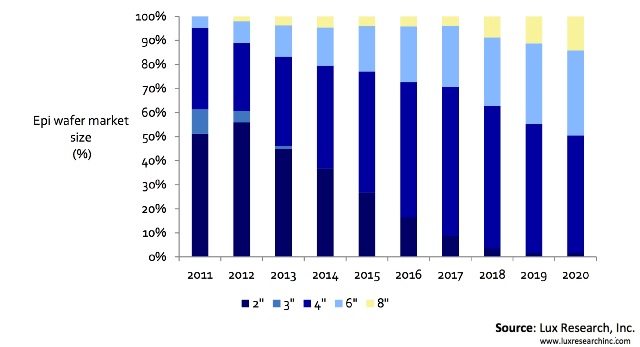Jul 19 2013
As LED lighting becomes an $80 billion industry, the market for the epitaxial wafers (epi-wafers) LEDs are made from will grow to $4 billion in 2020, according to Lux Research.

The vast majority of these epi-wafers are gallium nitride (GaN)-on-sapphire today. GaN-on-silicon is the leading emerging technology with a strong economic allure – silicon is just one-eighth the cost of a sapphire substrate – but technical challenges will limit it to only a 10% market share in 2020. GaN-on-silicon carbide (SiC), championed by Cree, will grow to 18% market share.
“Silicon is already widely used for electronics, and some LED die manufacturers are hoping to take advantage of silicon substrates,” said Pallavi Madakasira, Lux Research Analyst and lead author of the report titled, “Dimming the Hype: GaN-on-Si Fails to Outshine Sapphire by 2020.” “But GaN-on-Si is more prone to cracking than GaN-on-sapphire, and mitigating this mismatch is expensive,” she added.
Lux Research analysts studied the market for GaN-on-sapphire, GaN-on-SiC, GaN-on-bulk GaN, and GaN-on-Si epi-wafers, evaluating each technology's economic prospects as the industry moves to larger wafer sizes. Among their findings:
- Choice and cost of LEDs will determine adoption. Where GaN-on-sapphire is suited to all applications, GaN-on-bulk GaN will be relegated to niche commercial lighting and GaN-on-Si, with unproven performance, will be better suited to cost-sensitive residential applications.
- Four-inch wafers will rule, though six-inch wafers start to come into vogue. Four-inch wafers will peak at 62% market share with $2.1 billion in 2017 sales. Later, the LED industry will move towards 6” epiwafers, which will take a 35% share, equivalent to $1.4 billion, in 2020.
- Technology will advance sapphire substrates. Sapphire substrate manufacturing technology has advanced significantly with specialists such as Rubicon and Monocrystal demonstrating substrates up to 12” in diameter. New methods like hydride vapor phase epitaxy (HVPE) will further improve throughput and cut costs, keeping sapphire highly competitive for the rest of the decade.
The report, titled “Dimming the Hype: GaN-on-Si Fails to Outshine Sapphire by 2020,” is part of the Lux Research Energy Electronics Intelligence service.